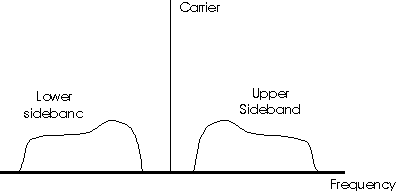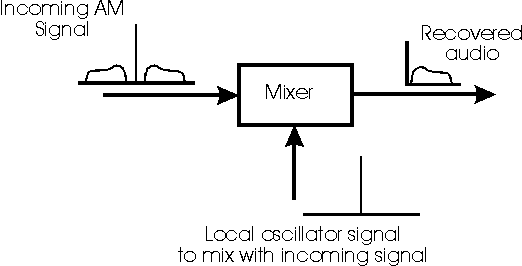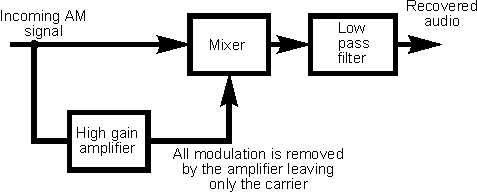Synchronous demodulation / detection
Today's radio receivers offer very high levels of performance and boast many
facilities. Many radio receivers incorporate memories, phase locked loops,
direct digital synthesis, digital signal processing and much more. One facility
that can be very useful on the short wave bands is synchronous detection or
synchronous demodulation as this can give much improved performance for
receiving amplitude modulation (AM) transmissions. Unfortunately little is
written about this form of modulation, and often it is a matter of accepting
that it must be better than any normal options because it is included as a
feature in the receiver specification.
Synchronous detection is used for the detection or demodulation of amplitude
modulation (AM). This form of modulation is still widely used for broadcasting
on the long, medium and short wave bands despite the fact that there are more
efficient forms of modulation that can be used today. The main reason for its
use nowadays is that it is very well established, and there are many millions of
AM receivers around the world today.
In any receiver a key element is the detector. Its purpose is to remove the
modulation from the carrier to give the audio frequency representation of the
signal. This can be amplified by the audio amplifier ready to be converted into
audible sound by headphones or a loudspeaker. Many receivers still use what is
termed an envelope detector using a semiconductor diode for demodulating AM.
These detectors have a number of disadvantages. The main one is that they are
not particularly linear and distortion levels may be high. Additionally their
noise performance is not particularly good at low signal levels.
These detectors also do not perform very well when the signal undergoes
selective fading as often occurs on the short wave bands. An AM signal contains
two sidebands and the carrier. For the signal to be demodulated correctly the
carrier should be present at the required level. It can be seen that the signal
covers a definite bandwidth, and the effects of fading may result in the carrier
and possibly one of the sidebands being reduced in level. If this occurs then
the received signal appears to be over-modulated with the result that distortion
occurs in the demodulation process.

The spectrum of an amplitude modulated signal
Diode envelope detector
In virtually every receiver a simple diode envelope detector is used. These
circuits have the advantage that they are very simple and give adequate
performance in many applications.
The circuit of a typical detector is shown in Figure 2. Here the diode first
rectifies the signal to leave only the positive or negative going side of the
signal, and then a capacitor removes any of the remaining radio frequency
components to leave the demodulated audio signal. Unfortunately diodes are not
totally linear and this is the cause of the distortion.

An envelope detector for AM signals
What is synchronous demodulation
Signals can be demodulated using a system known as synchronous detection or
demodulation. This is far superior to diode or envelope detection, but requires
more circuitry. Here a signal on exactly the same frequency as the carrier is
mixed with the incoming signal as shown in Figure 2. This has the effect of
converting the frequency of the signal directly down to audio frequencies where
the sidebands appear as the required audio signals in the audio frequency band.
The crucial part of the synchronous detector is in the production a local
oscillator signal on exactly the same frequency as the carrier. Although it is
possible to receive an AM signal without the local oscillator frequency on
exactly the same frequency as the carrier this is the same as using the BFO in a
receiver to resolve the signal. If the BFO is not exactly on the same frequency
as the carrier then the resultant audio is not very good.

Synchronous demodulation
Fortunately this is not too difficult to achieve and although there are a
number of ways of achieving this the most commonly used method is to pass some
of the signal into a high gain limiting amplifier. The gain of the amplifier is
such that it limits, and thereby removing all the modulation. This leaves a
signal consisting only of the carrier and this can be used as the local
oscillator signal in the mixer as shown in Fig. 4. This is most convenient,
cheapest and certainly the most elegant method of producing synchronous
demodulation.

A synchronous detector using a high gain-limiting
amplifier to extract the carrier
Advantages of synchronous detection
A synchronous detector is more expensive to make than an ordinary diode detector
when discrete components are used, although with integrated circuits being found
in many receivers today there is little or no noticeable cost associated with
its use as the circuitry is often included as part of an overall receiver IC.
Synchronous detectors are used because they have several advantages over
ordinary diode detectors. Firstly the level of distortion is less. This can be
an advantage if a better level of quality is required but for many
communications receivers this might not be a problem. Instead the main
advantages lie in their ability to improve reception under adverse conditions,
especially when selective fading occurs or when signal levels are low.
Under conditions when the carrier level is reduced by selective fading, the
receiver is able to re-insert its own signal on the carrier frequency ensuring
that the effects of selective fading are removed. As a result the effects of
selective fading can be removed to greatly enhance reception.
The other advantage is an improved signal to noise ratio at low signal
levels. As the demodulator is what is termed a coherent modulator it only sees
the components of noise that are in phase with the local oscillator.
Consequently the noise level is reduced and the signal to noise ratio is
improved.
Unfortunately synchronous detectors are only used in a limited number of
receivers because of their increased complexity. Where they are used a
noticeable improvement in receiver performance is seen and when choosing a
receiver that will be used for short wave broadcast reception it is worth
considering whether a synchronous detector is one of the facilities that is
required.
|

